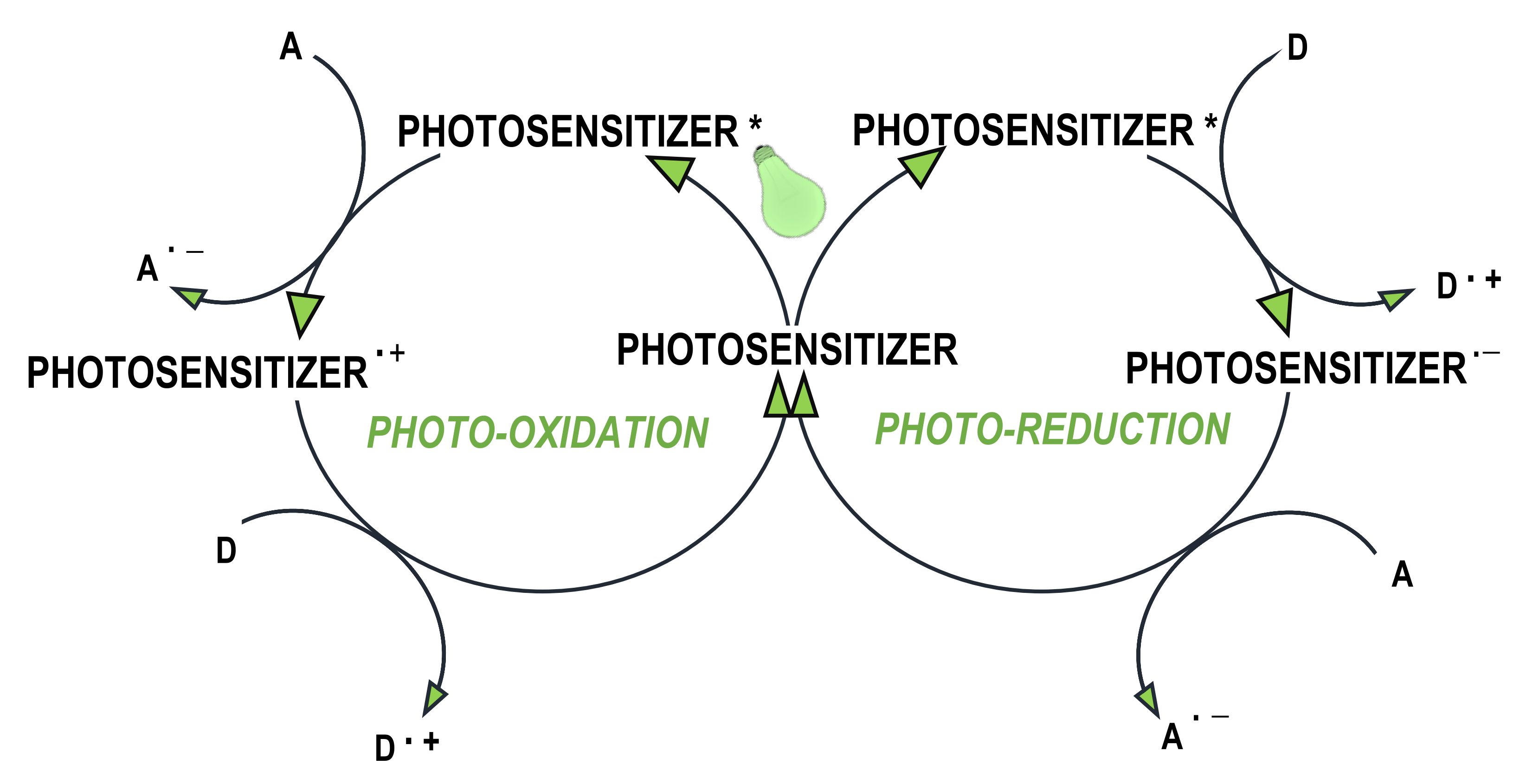Light-initiated polymerization processes are currently an important tool in various industrial fields. The advancement of technology has resulted in the use of photopolymerization in various biomedical applications, such as the production of 3D hydrogel structures, the encapsulation of cells, and in drug delivery systems. The use of photopolymerization processes requires an appropriate initiating system which, in biomedical applications, must meet additional criteria: high water solubility, non-toxicity to cells, and compatibility with visible low-power light sources. This article is a literature review on those compounds that act as photoinitiators of photopolymerization processes in biomedical applications. The division of initiators according to the method of photoinitiation was described and the related mechanisms were discussed. Examples from each group of photoinitiators are presented, and their benefits, limitations and applications are outlined.
- water-soluble photoinitiators
- type I photoinitiators
- type II photoinitiators
- two-photon initiators (2PP), photopolymerization
- biomedical applications
- free-radical photopolymerization
- cationic photopolymerization
Figure 1. Graphical abstract.
Currently, polymerization processes are one of the most widely used chemical processes in various fields of industry[1][2]. One of the most modern and rapidly developing methods of obtaining polymers is light-induced polymerization, i.e., photopolymerization[3][4]. The technique of converting liquid monomers to solid polymers under the influence of applied light is widely developed in the polymer materials sector in the industry of solvent-free paints, varnishes, and adhesives, in optoelectronics, in the printing industry for 3D printing materials, and many others[5][6][7][8]. Numerous advantages of photopolymerization, such as performing reactions at ambient temperature, lack of solvents, and extremely short processing times, made light-initiated polymerization perfectly suited for biomedical applications (Figure 1)[9][10].
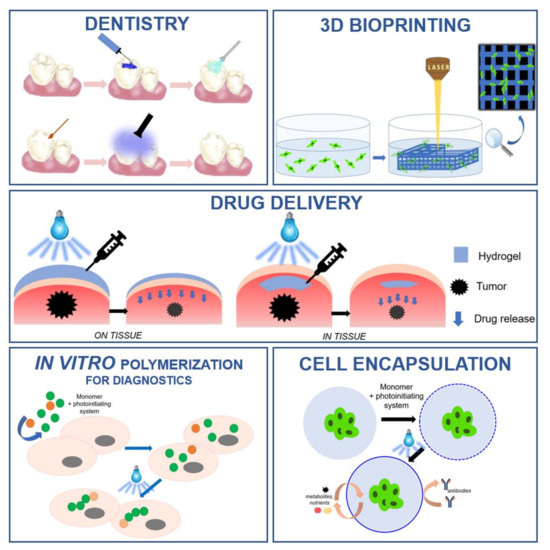
Figure 2 . Examples of light-induced polymerization processes in biomedical applications.
. Examples of light-induced polymerization processes in biomedical applications.The global market for photopolymerization in biomedical applications can be divided into various groups based on the area of application in the medical sector. The main segments are: dentistry [11][12][13], tissue engineering[14][15][16], bioimaging[17][18], drug delivery systems[19][20], and medical devices. In dentistry, photochemical-initiated processes are used for the filling of hard dental tissue cavities with photocured polymer composites[21][22][23]. An interesting application of photopolymerization processes is the production of photo-crosslinked polymeric biomaterials especially those based on totally or partially degradable materials[24][25][26], scaffolds for tissue culture[27][28][29], and diagnostic genetic or cellular matrixes[30][31][32][33][34][35].
The unquestionable advantages of the photopolymerization technique in the context of applications in tissue engineering and biomedical science are primarily its ability to form structures of any geometry as well as the deposition of such materials on various carriers. Lack of these possibilities is often a limitation of the functionality of biomaterials obtained through conventional polymerization processes.
Due to the mechanisms of polymerization as well as the type of used monomers and initiating systems, there is a distinction between radical photopolymerization and cationic photopolymerization, which are the basic processes used in light-initiated polymerization technologies. Radical photopolymerization is a chain reaction consisting of three main stages: initiation, propagation, chain growth, and termination (which may be accompanied by side reactions). Free-radical photopolymerization is mainly used for acrylate and methacrylate monomers. The factor that limits the usefulness of radical photopolymerization is the occurrence of oxygen inhibition caused by the presence of atmospheric oxygen during the polymerization process. The negative influence of oxygen on polymerization is reflected, for example, by extinguishing the excited states of the initiator, which, in turn, affects the efficiency of the whole process. It is the free-radical polymerization, however, that is mostly used in biomedical applications, as proven by numerous literature reports[36][37][38][39].
The second type of polymerization is cationic photopolymerization, which is particularly interesting and relatively widespread in industrial applications, since it has a number of major advantages that make this process practical. The living nature of cationic photopolymerization guarantees that the reaction continues to be effective even after shutting down the radiation source. This enables a high degree of conversion to be achieved, which plays an extremely important role in the industrial practice. For this reason, photoinitiated cationic polymerization is becoming increasingly prevalent in global markets as an easy and energy-saving method for obtaining cross-linked polymers[40][41]. Despite its numerous advantages, cationic polymerization is very unlikely to be used in biomedical applications. One of the reasons is that cationic initiators generate strong protonic acids during initiation, whose acidic character negatively affects cell cultures[42]. The second reason is the sensitivity of cationic photopolymerization to moisture and water. Numerous scientific articles prove that the presence of water slows down or inhibits the polymerization reaction. In addition, water can act as a chain transfer agent and promote the growth of new chains, which reduces the average molecular weight of the obtained polymer[43].
One of the basic requirements of photocuring systems used in biomedical sciences is their total or partial solubility in water. Water-based photocuring systems have already garnered interest since the late 1970s. Even then, it was well known that the use of water as a non-toxic, green, and cheap solvent was the solution to many problems related to the classical, organic compositions[44]. In addition, aqueous formulations can, in many cases, provide a reaction efficiency that cannot be achieved with conventional organic systems. Interestingly, the oxygen concentration in aqueous systems is an inch lower than in organic preparations, which significantly reduces oxygen inhibition for radical photopolymerization processes. Therefore, the use of water-soluble photoinitiators in aqueous systems for light-initiated polymerization is of great importance in the rapidly growing medical industry, and this article provides an overview of the literature related to the development of water-soluble initiators and their use in biomedical applications.
Types of photoinitiators
The initiating systems based on one-component, two-component or multi-component photoinitiators undoubtedly play a key role in photopolymerization processes[45][46][47]. Photoinitiating systems not only determine the mechanism of the reaction, but also affect its performance, curing speed and final properties of the polymer, such as hardness and viscosity. The selection of a photoinitiator is essential to achieve the right photopolymerization reaction rate and the desired polymer properties. The basic parameters determining the selection of the photoinitiator are, among others, maximum absorption wavelength λmax and molar extinction coefficient ε. The efficiency of the photoinitiator is directly related to its structure, which influences the range of absorption and quantum efficiency of the photochemical and photophysical processes taking place in excited states[48]. Regardless of the type and mechanism of initiation, the photoinitiator should exhibit the following features (Figure 3):
- compatibility between the absorption characteristics of photoinitiators and the emission characteristics of the light source
- high quantum efficiency
- good solubility in the polymerized composition – for biomedical applications – good water solubility
- non-cytotoxicity
- should not cause yellowing of the cured product
- thermal and temporal stability
Other factors to be taken into account when performing the photopolymerization reaction are the structure and physicochemical properties of the monomers, the phenomenon of oxygen inhibition (in the case of free-radical polymerization), the influence of stabilisers or other additives present in the monomers, the thickness of the polymerizing layer, the type and intensity of the light source and the viscosity of the composition. In the case of an in vivo photopolymerization reaction, it is particularly important to reduce the toxicity of the initiator, especially when exposed to light. Free radicals produced during initiation may react with the main components of living cells, such as proteins and nucleic acids, which may affect the condition and viability of cells. Based on the mechanism of initiation of photoinitiators, a distinction is made between radical and cationic photoinitiators. In biomedical applications, radical photopolymerization processes are dominant.
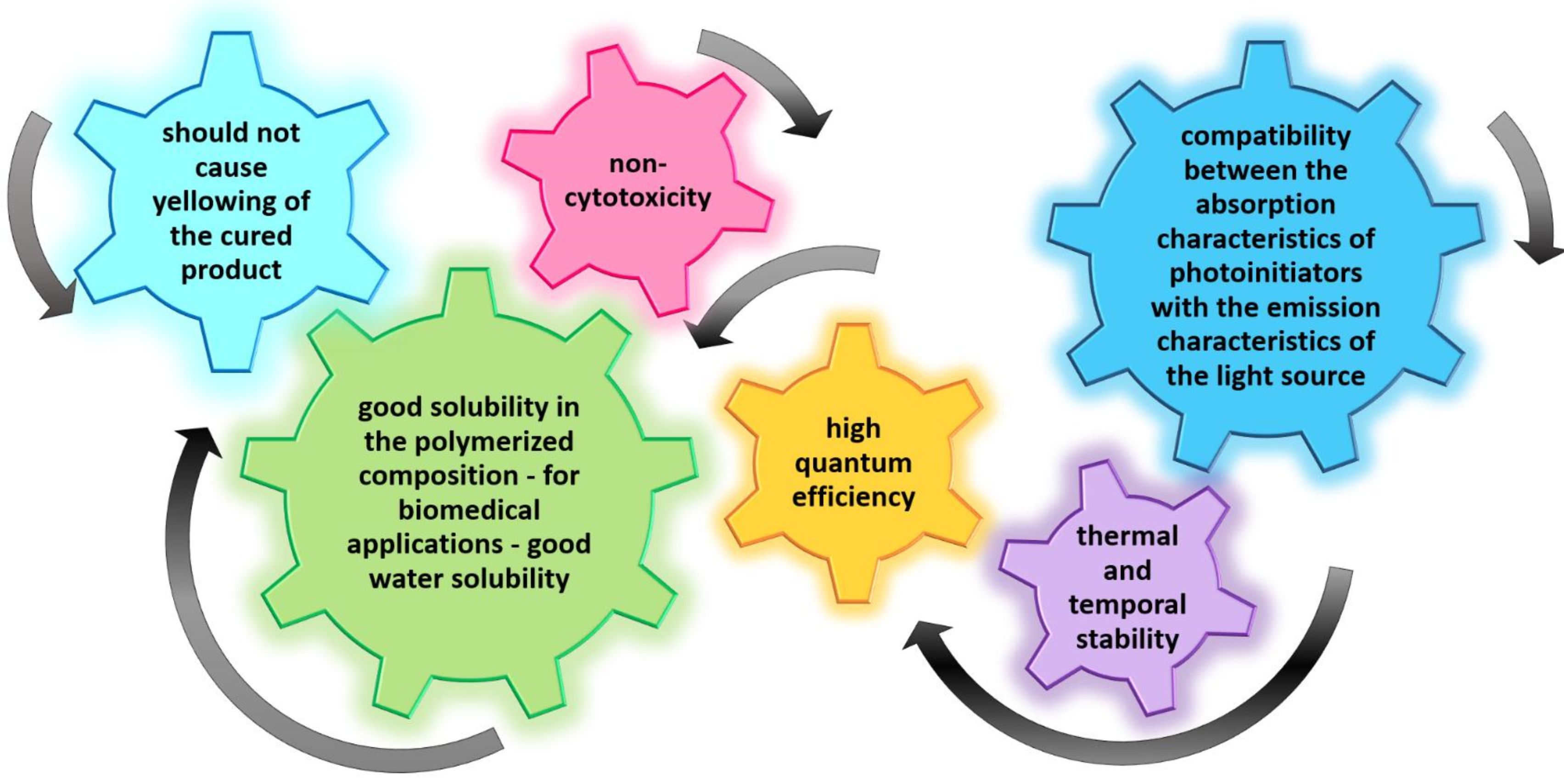
Figure 3. Highlights of initiators' requirements.
Free-radical photopolymerization is an example of a classic photochemical chain reaction in three main stages: initiation, propagation and termination, leading to the formation of oligomers or polymers[49]. Depending on the structure of a radical photoinitiator, free radicals may be formed in the process of homolytic photodissociation of the photoinitiator molecule – type I photoinitiators. This group of photoinitiators includes peroxides, peresters, iminosulphones or ketones, where photofragmentation is performed by binding, for example, O-O, S-S, S-N or C-C at α or β – carbon atom to the carbonyl group[50]. In the case of Type II photoinitiators, the excited initiator molecule reacts with the appropriate co-initiator, for example, an electron donor or acceptor, or a hydrogen donor in order to produce the appropriate radicals or radical-ions[51]. The photoinitiation process using type I or type II initiators is presented in Figure 4. Types I and II photoinitiations are single- and two-molecular processes respectively. The second type is usually slower and less efficient due to the presence of competitive processes during the excitation of the photoinitiator by the monomer, co-initiator and atmospheric oxygen. Conversely, the photon energy in the visible range is generally lower than the dissociation energy of individual organic compound bonds, so it is particularly difficult to obtain a highly efficient initiator operating in the visible range. Therefore, it is often in this range that the bimolecular systems are used. Examples of Type I initiators are: Irgacure 2959[52], LAP [53], BAPO-OLi[54][55], VA-086[56], and as Type II initiators following compounds are used: Eosine Y[57], Camphorquinone[58], Riboflavine[59].
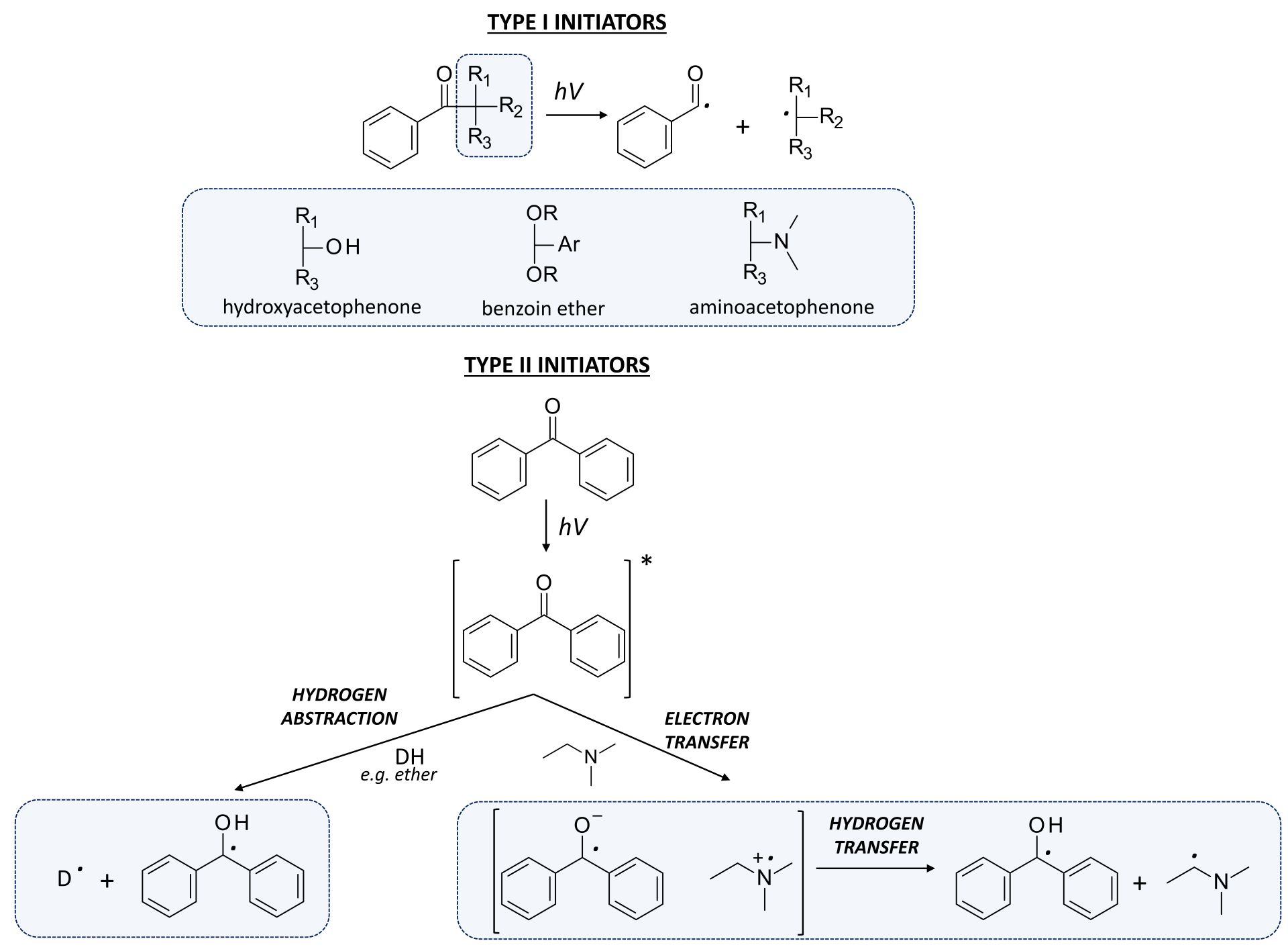
Figure 4. The photoinitiation process using: A. type I initiator; B. type II initiator.
Currently, multi-component photoinitiation systems, based on electron transfer, and systems based on hydrogen abstraction, are interesting options. The reaction of electron transfer is based on the interaction of an excited electron donor or acceptor with a second component (electron acceptor or donor respectively) in the ground state, which is responsible for the photoinduced electron transfer process. An excited photosensitiser molecule, as the primary light absorber in multiradical systems, can perform a dual role (Figure 5) [60]:
- where the photosensitiser acts as an electron donor, the transfer of the electron to the co-initiator creates a cationic radical of the sensitiser particle and an anionic radical of the co-initiator;
- where the photosensitiser is an electron acceptor, it undergoes photoreduction, and the electron transfer products are the anionic radical formed on the sensitiser molecule and the cationic radical formed on the co-initiator.
Figure 5. Initiation in multi-component systems: D – electron donor; A – electron acceptor.
In addition to the classic single, binary and multi-component photoinitiators, there are also two-photon initiators (2PP) that undergo two-photon polymerization. This type of process is a powerful tool to build a variety of 3D matrices with micro- and nano-accuracy. Two-photon polymerization process is characterised by high penetration depth and high spatial selectivity. In this case, it is possible to use live cells to create 3D structures, thanks to the use of low-energy photons, which are safe for cells[61]. Two-photon photoinitiators should be sensitive to absorption because during the initiation they absorb two photons from the near infrared (NIR) area. In addition, they are characterised by highly conjugated π-systems and strong donor–acceptor groups[42]. The initiation process is not fully clarified, but it is suspected that after absorbing the photons, the electron is transferred from the initiator's donor–acceptor group to the π-electron core[62]. The transfer of the electron between the initiator and the monomer generates an exciplex and results in the formation of radicals that initiate the polymerization reaction (Figure 6)[63]. Examples of two photon initiators are: WSPI[64], BDEA[65], P2CK[66].

Figure 6. Schematic mechanism of initiation using two-photon photoinitiators.
Summary of the main water-soluble initiators used in biomedical applications, their basic properties and photoinduced cleavage of photoinitiators is presented below:
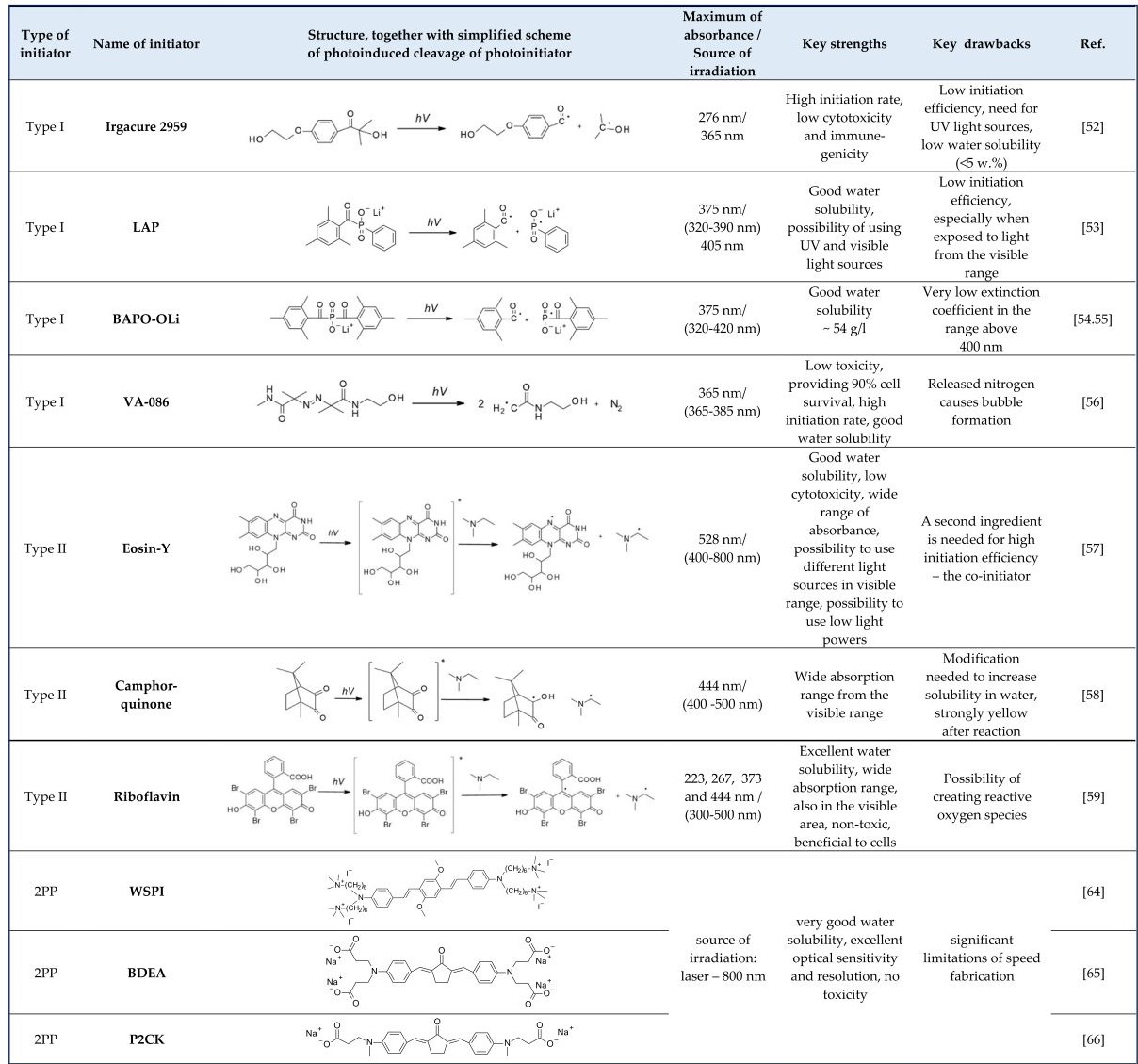
Figure 7. Summary of the main water-soluble initiators used in biomedical applications, their basic properties and photoinduced cleavage of photoinitiators.
Fields of application for water-soluble photoinitiators
In recent years, polymeric hydrogels have garnered a lot of interest in terms of their potential application, due to the fact that their structural and biochemical properties are similar to those of the extracellular matrix (ECM) of most tissues[67] . Moreover, they show high porosity, which ensures high permeability to nutrients, oxygen and metabolic products. The properties of these materials can also be adapted to the mechanical properties of soft tissues. Hydrogels for tissue engineering should be hydrophilic in order to promote cell adhesion, while the three-dimensional structure of these scaffolds should be porous to facilitate cell and nutrient diffusion[68]. Hydrogels are produced by cross-linking hydrophilic monomers or oligomers. Although hydrogels can be formed by conventional polymerization methods, e.g. thermally, using thermal initiators or initiators acting on the principle of redox reaction, polymerization under the influence of light is of greatest interest. Compared to other methods, photopolymerization has many advantages: it is a very fast reaction (lasting from a few seconds to a few minutes) and allows spatial control over the resulting hydrogel, which permits the creation of various shapes that fit into the tissue structure. Currently, photoinduced systems for the production of hydrogels include: radical polymerization under the influence of ultraviolet (UV) and visible (Vis) lights in water, or two-photon photopolymerization and thiol-en photopolymerization[69][68]. Hydrogels with an interpenetrating polymer network structure are also becoming increasingly more popular[70]. Photocured hydrogel materials are used in numerous applications, e.g. biosensing[71][72], encapsulation[73], drug delivery systems[74], scaffolding for cell culture [75][76], in situ polymerization[77] and even direct polymerization in living cells[78][79]. All techniques of 3D printing are highly developed , including laser writing [80][81], inkjet bioprinting[82] and stereolithography[83]. Other applications include the production of various materials, including scaffolds[84] and layered hydrogels using surface photopolymerization[85].
Conclusion and outlook
In conclusion, interest in water-soluble photoinitiators has been ongoing for almost half a century. Significant developments in medicine, including nanomedicine, promote the advancement of photopolymerization processes, as well as the necessary initiating systems in the near future. The currently available modern technologies of nanomedicine, such as targeted drug therapy, modern analysis and diagnostics of diseases, and the production of materials for cell or tissue culture, will require new and increasingly improved initiators that will meet all the criteria for the introduction of materials into the medical market.The development of water-soluble initiating systems is likely to take two directions. First, it will be based on the synthesis of completely new Type I or Type II photoinitiators, with a wide absorption range reaching the visible range and, additionally, fulfilling a number of other requirements, such as lack of cytotoxicity, biocompatibility and high initiation efficiency. Such photoinitiators can be applied, among others, in the processes of in situ polymerization, in targeted drug delivery and in cell encapsulation, which may positively affect the treatment of some diseases, such as type I diabetes by the encapsulation of islets of Langerhans.The second direction of development is the study of two-photon photoinitiators (2PP), which will allow the effective production of hydrogel materials containing living cells with the use of 3D laser printing with extremely high resolution. The constant challenge is to obtain initiators with a simple and inexpensive synthesis path, the scale of which can be easily transferred to the industry.This literature review has presented previous achievements in the field of water-soluble initiators in biomedical applications and has pointed at likely development paths and potential applications of photopolymerization processes.

